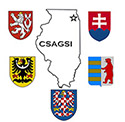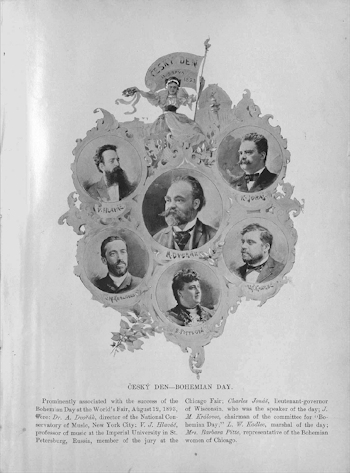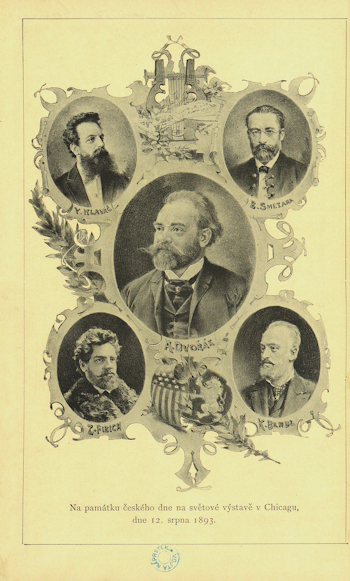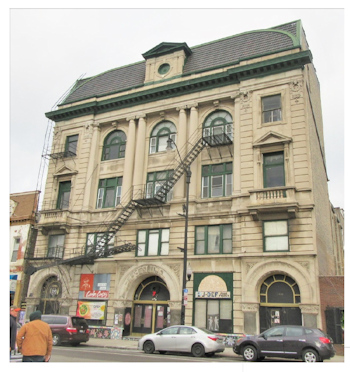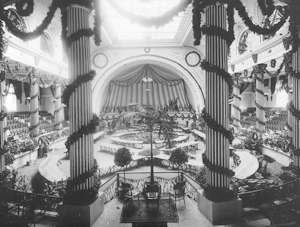
Three comprehensive articles have been found which focus on Bohemian Day.
- Recollections of the 1893 Chicago World's Columbian Exposition and Czech Day at the Fair (A)
- Cesky Den - Bohemian Day (B)
- Amerikan Kalendar, 1894 (C)
The articles and the numerous newspaper articles found on Bohemian Day provide information on one, two or three of the main events of the day. (Parade - Music and Speeches in the Festival Hall (Choral Hall), and demonstrations of athletics and athleticism in the Live Stock Pavilion) Several provide some background as to how Bohemian Day became an event at the Columbian Exposition. (Above Ticket is for visual purposes only, not an actual ticket)
 On April 25, 1890 President Benjamin Harrison signed the bill which provided for the establishment of the World's Columbian Exposition in Chicago. On April 23, in anticipation of that bill signing, the Chicago Tribune, on page 1, provided a comprehensive description of that bill and its components. A key opening statement to the bill was "An act to provide for celebrating the 400th anniversary of the discovery of America by Christopher Columbus by holding an International Exhibition of arts, industries, manufactures, and the product of the soil, mine. and sea in the City of Chicago, in the State of Illinois."
On April 25, 1890 President Benjamin Harrison signed the bill which provided for the establishment of the World's Columbian Exposition in Chicago. On April 23, in anticipation of that bill signing, the Chicago Tribune, on page 1, provided a comprehensive description of that bill and its components. A key opening statement to the bill was "An act to provide for celebrating the 400th anniversary of the discovery of America by Christopher Columbus by holding an International Exhibition of arts, industries, manufactures, and the product of the soil, mine. and sea in the City of Chicago, in the State of Illinois." 
In 1890, Bohemia was a region of the Austro-Hungarian Empire. While the Exposition did have official exhibits from Austria, Hungary did not have the same, and while examples of Bohemian arts and products would be found in several Austrian displays. There was no official Bohemia, but, through hard work of Bohemians, there would be a Bohemian Day at the Exposition. The Bohemians were not the only group to have "their day" at the Exposition, though fewer seemed to be as successful as the Bohemian Day of August 12, 1893. (Image Right: Rand McNally "Bird's Eye View of the World's Fair - Library of Congress - https://www.loc.gov/resource/g4104c.pm001522?r=-0.033,0.094,1.003,0.59,0)
No article found so far yields a date, or approximate date, when the planning and organization for Bohemian Day at the Exposition began.
All three of the comprehensive articles found have an image, and names for individuals who helped in its organization, or participated in a leadership role in the event.
Image Left: Reference (B)
Image Right: Reference (C)
Image Above Left: Dr. A. Dvorak, Director of Music, National Conservatory of Music, New York: V.I. Hlavac, Professor of Music, Imperial University of St. Petersburg; Charles Jonas, Lieutenant Governor of Wisconsin; J.M. Kralovec, Chairman of the Committee For Bohemian Day; L.W. Kadlec, Parade Marshall; Mrs. Barbara Pitte, Representative of the Bohemian Women of Chicago.
Image Above Right: Composers of music played in the Festival Hall during Bohemian Day: A. Dvorak, V. Hlavac, B. Smetana, Z. Fibich, K. Bendl.
The Parade
Bohemian Day Coming
The Indianapolis News, Indianapolis, Indiana, Monday, July 31, 1893, Page 1.
……..It is expected that from 10,000 to 15,000 Bohemians will take part in the procession. There are about 300 Bohemian societies in Chicago alone. Special excursion trains will be run from Omaha, Cleveland, and other principal cities where Bohemians reside, and on August 12 the Chicago Bohemian day will be a truly national day, for all factions are vying with each other for the success of the celebration.
Bohemians Celebrate Today
Chicago Tribune, Chicago, Illinois, Saturday, August 12, 1893, Page 3.
They will Parade. Listen to Concerts and Speeches, and Have Games.
This will be Bohemian day in the city and at the Exposition. The 300 Bohemian societies of Chicago have been receiving reinforcements all the week from Omaha, Cleveland, and other large cities. The celebration begins with the parade of this morning, in which it is expected that 15,000 persons will march. In the procession will be carried a banner made by the women of Bohemia, and by them presented to their countrymen in America, in recognition of the assistance of the Bohemian Americans in sustaining private schools. The floats, of which there will be many, will illustrate the victory of the bohemians over the Tartars, the founding of the University of Prague, Prince Krok and his three wise daughters, the introduction of Christianity into Moravia, and the victory of the Hussites over the Crusaders. The trades also will be fully illustrated. Religious lines will be completely ignored.
The down town procession will move at 8 o’clock sharp, tomorrow morning, starting from Ashland avenue and Eighteenth street, east to Halsted street, north to Jackson street, east to Dearborn street, north to Adams street, east to Michigan avenue, south to Van Buren street.
Tis Bohemian Day
The Oshkosh Northwestern, Oshkosh, Wisconsin, Saturday, August 12, 1893, Page 1.
Chicago, Aug. 12 – It is calculated that over 100,000 Bohemians have arrived in this city during the past twenty-four hours to participate in the celebration of Bohemian day at the World’s fair. The demonstration has more than a passing interest, owing to the fact that the date was chosen a week earlier than that for the Austro-Hungarian celebration, in order that the Bohemians might signify their dissatisfaction with the existing relations between their fatherland and the ruling power. Beyond the withdrawal of the Bohemians from the Austrian celebration, however, no action of a political character will be taken.
The parade in the down town streets with which the festivities were inaugurated this morning, contained in the neighborhood of 15,000 Bohemians and Bohemian-Americans, and as indicated by their banners, included representatives of every school of thought from atheism to the orthodox creeds. The line disbanded shortly after noon, and the participants immediately repaired to the fairgrounds, where a mass meeting, a natives concert and athletic contests were held this afternoon.
Bohemia at the Fair
The Chicago Tribune, Chicago, Illinois, Sunday, August 13, 1893, Page 2.
Its People Celebrate Lustily Their Day In The White City
Dvorak and Hlavac delight them at Festival Hall, after they had had a big parade down town. Lieut. Gov. Jonas of Wisconsin delivers an oration, then the Athletic Exercises take place.
Bohemia ruled the World’s Columbian Exposition yesterday. It was the special date set apart for that nationality, and its citizens invaded the White City at every entrance by the thousands. They went early and stayed late. The red and white colors under which they and their brave forefathers have been fighting for liberty more than 200 years were prominently in evidence everywhere. Music and singing societies, athletic associations and school leagues, sharpshooters, Bohemian American Knights, rowing clubs, secret society orders, benevolent bodies, labor unions, and many other organizations were out in great numbers. There were visiting Bohemians from New York, Milwaukee, and Cleveland, Omaha, and many other cities and towns. It was a great day for the American Bohemian population all around. They had shown themselves off to the multitudes down town in a gorgeous street parade some two or three miles long and reached the Fair ground between 11 and 12 o’clock full of excitement and enthusiasm. It was an interesting sight to witness the scrambling style in which they crowded the Illinois Central trains, the Elevated trains, the cable cars, the boats, and every other means of transportation to the center of attraction. As far as possible the organizations made the trip in bodies. There were 500 athletic young men in blue roundabouts and gray trousers and 300 girls in blue dresses and caps, experts in dumb bell swinging that attracted much attention, and the singing societies in white and blue.
The morning parade was through the streets in the southwest wards of Chicago. By 8 o’clock most of the organizations were at the rendezvous, Eighteenth street and Ashland avenue. The streets in this locality were thronged with people and many of the buildings were decorated. Occasionally the ensigns of Austria were noticed. Fully 10,000 men were in line. The Turner societies were out in force and all the Bohemian organizations were represented. Many allegorical floats, represents events in history, had place. The procession required two hours in passing any given point. The line of march was from Ashland avenue to Eighteenth street, east to Halsted street, north to Jackson street, east to Dearborn street, north to Adams street, east to Michigan avenue, south to Van Buren street. L.W. Kadlec was Grand Marshal.
Czechs All of Them
The Inter Ocean, Chicago, Illinois, Sunday, August 13, 1893, Page 5.
Bohemian day was a big one. The appearance of the exposition grounds indicated that it drew out the cream of the Czech population. Bohemians were among the first to come through the gates in the morning, and until late in the afternoon parties with yellow and red banner were frequent arrival. They came in largest numbers soon after the breaking up of the procession downtown. Many prominent Bohemian citizens drove up to the Fair gates in gorgeously decorated carriages. Lieutenant Governor Jonas of Wisconsin, the orator of the day, came in this way, entering at the Sixty Second street gates, and going directly to Festival hall.
The Bohemian Voice, Volume 2, No. 1 September 1, 1893
https://digitalcommons.unomaha.edu/bohemian/
All the newspapers of Chicago, English, German, Bohemian, Polish, Italian, etc., concur in the opinion that the "Bohemian Day" at the 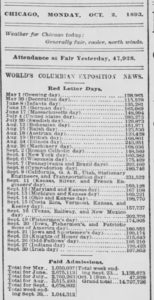 Chicago World's Fair, August 12, was a great success. Notwithstanding the frantic efforts of the Austrian Commissioner to induce our people to celebrate the "Austrian" day, the Bohemian secessionist remained true to his national colors of red and white, and, forgetting at least for one day the religious rancor which separates the freethinker from the Catholic and Protestant—marched out as a Bohemian, proud to do homage to his little native country. As a result of this happy union of our people, "Bohemian Day," August 12, saw by far the most imposing gathering of Bohemian people ever held abroad. The "Austrian Day" which was held one week later, August 18, paled into utter insignificance before Bohemia's great day; for while the marching columns of Bohemians comprised some 15,000 men and women, the "Austrians" had in line only about 700 in all! (Image Left - Attendance Information, Chicago Tribune, Monday, October 2, 1893, Page 1.) In enthusiasm that manifested itself everywhere, and, particularly in moral force, the Bohemian celebration towered far above the Austrian; the tone of the speeches too, contrasted remarkably. While the eloquent address of Mr. Jonas breathed the loftiest American patriotism, the Austrian speakers seemed to vie with each other in heaping fulsome praise upon a weakling emperor.
Chicago World's Fair, August 12, was a great success. Notwithstanding the frantic efforts of the Austrian Commissioner to induce our people to celebrate the "Austrian" day, the Bohemian secessionist remained true to his national colors of red and white, and, forgetting at least for one day the religious rancor which separates the freethinker from the Catholic and Protestant—marched out as a Bohemian, proud to do homage to his little native country. As a result of this happy union of our people, "Bohemian Day," August 12, saw by far the most imposing gathering of Bohemian people ever held abroad. The "Austrian Day" which was held one week later, August 18, paled into utter insignificance before Bohemia's great day; for while the marching columns of Bohemians comprised some 15,000 men and women, the "Austrians" had in line only about 700 in all! (Image Left - Attendance Information, Chicago Tribune, Monday, October 2, 1893, Page 1.) In enthusiasm that manifested itself everywhere, and, particularly in moral force, the Bohemian celebration towered far above the Austrian; the tone of the speeches too, contrasted remarkably. While the eloquent address of Mr. Jonas breathed the loftiest American patriotism, the Austrian speakers seemed to vie with each other in heaping fulsome praise upon a weakling emperor.
Every Bohemian must be satisfied with the success of the "Bohemian Day." And may the recollection of it animate us to new efforts and new victories!
Early in the morning the wearers of red and white rosettes—men, women and children — were scattered broadcast over Jackson Park. After the parade down town this number was added to in a manner that surprised even those who had expected a large attendance. With this latter delegation came bands of music, men wearing tbe gaudy uniform of some Bohemian organization, men wearing the blue jacket and gray hat and trousers of the Bohemian Turners, and girls wearing the blue dresses and black cap of their organizations. From that time they came in hundreds by street cars, elevated trains, Illinois Central Railroad, and the steamboat lines till it seemed as if Bohemia had emptied her entire population into the white city. Every face wore a happy expression in anticipation of the speeches, the music, and the games. The Bohemians came from almost every large city, and many of the smaller cities in the United States, and their number was swelled by the people of Chicago. Upon the members of the 300 Chicago Bohemian societies devolved the duty of preparing for and conducting this day of days at the fair, and they did it in a manner characteristic of the faithfulness and energy of the Bohemians. Many states, nations and societies have had "days" at the fair, but the grandest of them all must fall far back in the distance behind that of Bohemia.
Witnesses of the down-town parade wondered where so many Bohemians came from. Businessmen watched a while, then left on an hour's errand and returned. The procession was still moving. Off on another errand and back again an hour later. Bohemia's national air was wafted to their ears. Columns of uniformed men were still marching by. Gayly caparisoned horses bore carriages containing the flower of Bohemia's beauty. There was no single or double file business about the parade. The men marched eight abreast, so close that they almost stepped upon each other's heels. It was a notable parade, notable for its order and arrangement, notable for its fine marching, notable for its good music, its elaborate allegorical floats, notable most of all for the great outpouring of men who made up the procession. It was over two hours in passing a given point and 20,000 is a modest estimate of its strength. It was a splendid turnout. There were societies without number, all bearing insignia of some description and carrying banners on most of which Bohemia's lion was rampant. It was an even parade throughout. The music and the floats were well distributed throughout the long line, and kept the spectators rooted to the spot till the body had passed along. L. W. Kadlec was grand marshal of the day.
"Recollections of the 1893 Chicago World's Columbian Exposition and Czech Day at the Fair" (A)
The Grand Marshal of the Parade was L.W. Kadlec and the good order and precision was witness to the choice of him by the committee.  For this day Czech Chicago was clothed in the most beautiful holiday colors. All homes along 18th Street, the main Czech thoroughfare in Chicago, flew flags with Czech and American colors. To welcome the visitors a large and elaborate triumphal arch was constructed on 18th Street in front of the C.S.P.S. (C.S.A.) building. It bore the inscription “Vitame Vas”, (We welcome you). A similar arch was constructed by the Catholic Lodges in front of the St. Procopius Church at 18th and Allport Street. (Image Left: Lawrence C. Kadlec (C)
For this day Czech Chicago was clothed in the most beautiful holiday colors. All homes along 18th Street, the main Czech thoroughfare in Chicago, flew flags with Czech and American colors. To welcome the visitors a large and elaborate triumphal arch was constructed on 18th Street in front of the C.S.P.S. (C.S.A.) building. It bore the inscription “Vitame Vas”, (We welcome you). A similar arch was constructed by the Catholic Lodges in front of the St. Procopius Church at 18th and Allport Street. (Image Left: Lawrence C. Kadlec (C)
Barely after sunrise, the morning of August 12th, the participants gathered on the streets where their units were to march. The Sokol legions gathered in front of the Plzen Sokol on Ashland Avenue where they were enthusiastically greeted by random groups of onlookers. The trained Sokols were dressed in grey pants, leotards and jackets which nicely displayed their robust figures. Altogether they numbered 360 people and the view of that great vanguard was truly impressive. After them came the numerous students of the physical training school and the girls training groups dressed in colorful Kroj costumes. A Sokol wagon float presented the slogan “Homage to Sokol Thought”, was the most beautiful in the parade. It was prepared according to the design of Brother Jarka Kosar, a former member of the Zizkov Sokol, Praha, now a member of the Sokol of Chicago. (Image Right: Gathering on 18th Street for the parade (C))
on the streets where their units were to march. The Sokol legions gathered in front of the Plzen Sokol on Ashland Avenue where they were enthusiastically greeted by random groups of onlookers. The trained Sokols were dressed in grey pants, leotards and jackets which nicely displayed their robust figures. Altogether they numbered 360 people and the view of that great vanguard was truly impressive. After them came the numerous students of the physical training school and the girls training groups dressed in colorful Kroj costumes. A Sokol wagon float presented the slogan “Homage to Sokol Thought”, was the most beautiful in the parade. It was prepared according to the design of Brother Jarka Kosar, a former member of the Zizkov Sokol, Praha, now a member of the Sokol of Chicago. (Image Right: Gathering on 18th Street for the parade (C))
As the Sokol marchers proceeded other lodges followed and there was not a single Czech lodge in Chicago, either Catholic or Freethinkers, which was not represented in the parade. Experts stated there was a total of 20,000 persons in the procession, exceeding all previous matters of this type presented in Chicago. The wagon floats, names those of the Sokols, C.S.P.S. (CSA), Woodsmen, Pilsen Butchers and Catholic lodges were magnificent and greatly enhances the parade.
The Czech parade thru the city was organized into nine divisions with L.W. Kadlec as the Grand Marshal and an Honor Guard of 25 men headed by Police Captain Frantisek B. Barcal. Each division has a Sub-Marshal and a marching band. Division 1 has 6 Sub-Marshalls including such well known personages as Dr. F.J. Jirka, and Congressman Adolph J. Sabbath. This division was the Sokol Division including 18 Chicago units, visiting Sokols from Nebraska, Ohio, Iowa and Missouri, as well as two wagon floats and carriages for women Sokols.
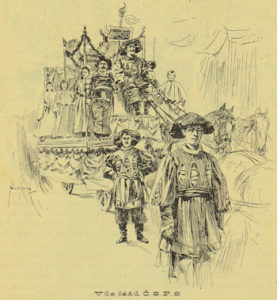 Division II was composed of Catholic Lodges with Jan Cermak as Marshall and 7 subdivisions each representing a church parish such as those of St. Wenceslas, St. John of Nepomuk, St Procopius, St. Vitus and others. Each unit had a float termed a “living picture”. An example is the St. Wenceslaus Church Float which depicted the baptism of Prince Borivoj (Krest Borivojuv) 874 A.D., the husband of St. Ludmilla. Division II featured 16 lodge groups and 3 marching bands.
Division II was composed of Catholic Lodges with Jan Cermak as Marshall and 7 subdivisions each representing a church parish such as those of St. Wenceslas, St. John of Nepomuk, St Procopius, St. Vitus and others. Each unit had a float termed a “living picture”. An example is the St. Wenceslaus Church Float which depicted the baptism of Prince Borivoj (Krest Borivojuv) 874 A.D., the husband of St. Ludmilla. Division II featured 16 lodge groups and 3 marching bands.
Division III included the uniformed groups such as Veterans, Sharpshooters, the George Washington Regiment, Czech American Knights and the Pilsen Butchers. Division IV included 33 C.S.P.S, (CSA) Lodges from Chicago and nationally, as well as the National Grand Lodge and the Illinois Grand Lodge. Division V included the Slavonic Lodges such as the Slovak Tatranska Jednota, the Serbian Montenegrins, a Red Cross unit and the Strossmayer #1 Lodge, parading with 40 carriages. (Image left: Parade Float (C))
Division VI included 12 Lodges of the Woodsmen, C.S.P.O. and C.S.B.P.J.. Division VII represented Union workmen, Tradesmen and Manufacturing Companies. Division VIII was composed of Czech singing societies, Musis groups and the Social and Dramatic Associations. Division IX, with three Sub-Marshalls, including Czechs from Algonqun, Michigan, Odd Fellow Lodges, Unity of Czech Women Lodges, The Free Thinkers, Czech Methodist Episcopal Church, Ceska Beseda, Association of Czech Tavern Owners, Jan Hus congregation from California and the scholarship for Czech American Jews.
A total of 600 carriages were included in the entire procession. It took two hours for the procession, with ranks of six people across, to pass a given point. The parade route started from 18th and Ashland Ave. at the Plzen Sokol, then east on 18th to Halsted, north to Jackson, east to Dearborn St., north to Adams St., east to Michigan Ave. and south to Van Buren St.. There the marchers boarded the Illinois Central train to Jackson Park (5900 South) and the Fair.
Image Left: Plzen Sokol at 1812 S. Ashland Avenue. Built in 1892 and added to in 1895, for the Bohemian Free Thought Association. Frank Randak, architect. (D)
Image Right Czesky Slavonsky Americky C.S.A.S. at 1436 to 1440 West 18th. Built in 1893 and expanded in 1902. Frank Randak, architect. (D)
The Concert at Festival (Choral) Hall
Dvorak Concert
The Inter Ocean, Chicago, Illinois, Friday, August 11, 1893, Page 6.
Bohemian day will be celebrated tomorrow in an appropriate manner at the World’s Fair. There will be a grand concert at Festival Hall, beginning at 12 noon, under the direction of Dr. Antonin Dvorak, of the National Conservatory of Music, New York, and Professor V.I. Hlavac, director of the Imperial orchestra, of St. Petersburg. There will be an address by Hon. Charles Jonas, Lieutenant Governor of Wisconsin. Gymnastic festivities and national games will take place in the arena at 3 pm. The concert selections are as follows: Overture, “The Bartered Bride,”, Smetana, Exposition orchestra of 114 men; songs, “Bohemian Chorale,”, Bendl, “The Star Spangeled Banner,” United Bohemian Singers of Chicago (mixed voices), conductor, Professor V.I. Hlavac; address, Hon. Charles Jonas, Lieutenant Governor of Wisconsin; symphony No. 41 in G major, Dvorak, conductor, Dr. Antonin Dvorak; funderal march, “The Bride of Messina, “Fibich: two Spanish pieces, Napravnik: conductor, Professor V.I. Hlavac, “Slavonic Dances,” II. Series, Dvorak, B. Major, E Minor, F Major, conductor, Dr. Antonin Dvorak. An act from the comic opera, “The Chase,” Hlavac; Mazurka, No. 8, Hlavac; conductor, Professor V.I. Hlavac, Overture, “My Country,”, Dvorak; conductor, Dr. Antonin Dvorak.
Dr. Antonin Dvorak, the eminent Hungarian composer, arrived in the city yesterday. He is a guest at the Lakota.
Dvorak Has Arrived
The Chicago Tribune, Chicago, Illinois, Saturday, August 12, 1933 Page 4
At the Bohemian Celebration at the Fair He will be a central figure. In bearing, the great master is retiring to a degree, contrasting greatly to some of his wild and thrilling music. Record of his career from penury to affluence. Arrivals at the hotels.
That famous Bohemian musician, Dr. Antonin Dvorak, who is to be a central features of the Bohemian day celebration at the Fair today, is at the Lakota Hotel with his wife and children. Besides being here for the musical concert in Festival Hall today noon, he wil enjoy the sights of the Exposition for a few days.
Dvorak loves to be among his own people and is the guest of Chicago Bohemians. He comes here from Spielville, Ia., a small Bohemian settlement. His rehearsals for his own music at the Fair today have been most thorough, occupying seldom less than three hours. In disposition he is modest and retiring and does not look near as fierce as would be supposed from his picture.
Bohemia at the Fair
The Chicago Tribune, Chicago, Illinois, Sunday, August 13, 1893, Page 2.
At 12 o’clock the chief exercises of the day were held in Festival Hall, which was packed with 8,000 people anxious to see the famous Antonin Dvorak and listen to his compositions as played under the influence of his own baton by the great World’s Fair Orchestra of 114 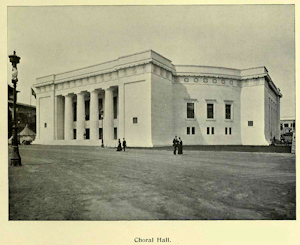 pieces. With the exception of an address by Lieut-Gov. Charles Jonas of Wisconsin, the program was devoted entirely to music, with Prof. Antonin Dvorak of New York and Prof. U.I. Hlavac of St. Petersburg as the conductors. (Image Left - Festival (Choral) Hall (Wikipedia Commons)
pieces. With the exception of an address by Lieut-Gov. Charles Jonas of Wisconsin, the program was devoted entirely to music, with Prof. Antonin Dvorak of New York and Prof. U.I. Hlavac of St. Petersburg as the conductors. (Image Left - Festival (Choral) Hall (Wikipedia Commons)
With Prof. V.I. Hlavac, whose appearance was the signal for loud applause, the bands played “The Barterede Bride,” as an overture. This was followed by two songs, the “Bohemian Chorale” and “The Star Spangled Banner,” by the United Bohemian Singers of Chicago. Prof. Hlavac presided at the organ. As the voices of the singers began to swell, the strains of the latter song the audience broke into a mighty roar of applause.
Lieut-Gov. Jonas, orator of the day, spoke first in English and then in his native tongue, reviewing briefly the progress of Bohemia in the development of industries of all kings, and of art and of literature, eulogized the Bohmians of America for their love of a free country, and their loyalty to the Stars and Stripes.
He praised the Exposition in most eloquent terms, pronouncing it worthy of the enterprise and genius of the greatest nation on the glove and the greatest city in that nation. Within half century, he predicted, Chicago would be the largest city in the world. Its Bohemian population is not greater than in any town in the world, except Prague. It is the metropolis of all the Bohemians in America. It was therefore extremely proper that the Fair management should set aside a day to be known as Bohemian day. The speaker was sorry that the banner of Bohemia was nowhere to be seen in the buildings in the White City, but he was proud that the products of Bohemian sill and invention occupied the most conspicuous positions in the Austrian section. He said in 1791 at Prague, Bohemia gave to the world the first exposition of the industries and liberal arts.
As Dvorak walked out upon the stage a storm of applause greeted him. For nearly two minutes the old composer stood beside the music rack, baton in hand, bowing his acknowledgments. The players dropped their instruments to join in the welcome.
Symphony No. 4 in G major, considered a severe test of technical writing as well as playing, was interpreted brilliantly. The orchestra caught the spirit and magnetism of the distinguished leader. The audience sat as if spell bound Tremendous outbursts of applause were given.
In the second part of the program Dr. Dvorak’s compositions were “The Slavonic Dances” in B major, E minor, and F Major, and “My Country,” and overture. Prof. Hlavac conducted the redition of “The Bride of Messina,”, a funderal march by Fibich; the Spanish Fandango, by Napravnik; two selections of his own, one from “The Chase,” a comic opera and the other a Mazurka.
Mr. Bitte read congratulatory telegrams from Bohemia.
The Bohemian Voice, Volume 2, No. 1 September 1, 1893
https://digitalcommons.unomaha.edu/bohemian/
The exercises at Jackson Park began at 12 o'clock with a concert at festival hall. Not a seat was vacant, and many were sitting in the aisles or standing. Not only were the selections, all by Bohemian composers, of a nature to please the most cultivated taste, but such close, respectful, admiring attention was given to every number that the finest 'pianissimo parts were distinctly heard. Upon the stage was an orchestra of 114 trained musicians. The seats extending from the stage to the organ in the rear were occupied by men and women who compose the United Bohemian Singers of Chicago. For the most part the women wore light-colored dresses, and these, set off by the bows of red and white ribbon they wore, were in harmony with the flags and banners.
Before the concert was begun, a number of cablegrams from Bohemia were read from the stage. Then walking briskly, a man with a heavy head of black hair, long, flowing black side whiskers, and wearing gold decorations about the neck and on the coat lapel, stepped to the conductor's stand, took up his baton, and rapped the orchestra to attention. It was Professor Y. J. Hlavac, professor of music at the Imperial University at St. Petersburg, a Bohemian of whom all Bohemians are proud. The vast audience greeted him with hearty applause, after acknowledging which, the professor conducted the orchestra through tire first number. At its conclusion he went above and presided at the organ while the grand chorus arose and sang "Bohemian Chorale." A storm of applause greeted the conclusion of the singing, proving the love still left in the hearts of the hearers for the mother country. Then the orchestra, in a grand burst of harmony, struck into the first bars of "The Star Spangled Banner." Bohemians have lived to learn what that music means, and when they recognized the strains of the national hymn of their adopted country the sounds of the orchestra were drowned in the storm of applause.
Then, Hon. Chas. Jonas, lieutenant governor of Wisconsin spoke as follows:
Fellow Citizens and Friends: "Chicago is at the present day the great meeting place of nations, a veritable rendezvous of mankind. This is a most remarkable distinction for a city not quite sixty years old. Universal expositions have been held in cities like London, Paris and Vienna, mentioned in the annals of history fifteen and even twenty centuries ago, but a universal exposition in a city which sixty years ago had no existence—that looks at the first glance like a wild dream, like a fable of the Arabian nights. And yet it is a grand reality. We see spread before our gaze a world's fair such as the world has never seen before—such as the world will not see again in many year to come.
"A gentleman perfectly competent to judge has repeatedly called Chicago a cosmopolitan city. I refer to the honorable mayor of the World's Fair city, Carter II. Harrison. Mayor Harrison is right, as he always is. Chicago is a cosmopolitan city, and hence it is emphatically an American city, because America is a cosmopolitan nation. Every nationality of the old world, every race of mankind is represented in the population of Chicago, which to-day numbers 1,500,000, which at the close of the present century will outnumber the population of any other city in the western hemisphere, and which in the course of the next century will outstrip the population of any other city in the world, Chicago probably contains more Germans than any European city excepting Berlin and Vienna; and Mayor Harrisonhas more Bohemian constituents, than the mayor of any city in Bohemia and Moravia with the sole exception of the capital city of Prague. Why, my friends, even the corporation counsel of Chicago, Adolph Kraus, is a Bohemian, and a right royal corporation counsel he is, and I suspect there is some Bohemian blood in the veins of Mayor Harrison.
"Hence it was fitting and proper to set apart a day, at this universal exposition distinctively to be known as Bohemian day, to prove to the people of Bohemian birth and descent that they are fully recognized as participants in that equality and fraternity which embraces every American citizen, no matter where his cradle stood or in what language the sweet accents of his mother's love may have found expression. We Bohemians are loyal citizens of the United States of America. We love and adore this great republic with its government of the people, by the people and for the people. We look with delight and admiration upon the starry flag, the banner of freedom, the glorious emblem of human rights and human equality. Our devotion to the star spangled banner is eloquently attested by the monument raised in the Bohemian cemetary of Chicago to the memory of those of our brethren who sacrificed their lives in defense of the Union when threatened by the southern rebellion. To use the words of that prominent American statesman, Carl Schurz, we love the country of our adoption with that fiery and enthusiastic devotion which a man feels for his chosen bride, but at the same time we love and cherish the memory of our dear old mother, the country of our birth. Therefore it is fitting to remember dear old Bohemia, especially on this day, which we celebrate as Bohemian day amidst the magnificent surroundings of the World's Fair."
Heard His Own Songs
The Inter Ocean, Chicago, Illinois, Tuesday, August 15, 1893, Page 3.
 Anton Dvorak heard his Slavonic dances played last night under circumstances that added new interest to the popular compositions. It was at a banquet given to the distinguished composer and his compatriots who are visiting the World’s Fair by the Bohemian Ladies of Chicago. (Image Left - Dvorak - Wikipedia Commons)
Anton Dvorak heard his Slavonic dances played last night under circumstances that added new interest to the popular compositions. It was at a banquet given to the distinguished composer and his compatriots who are visiting the World’s Fair by the Bohemian Ladies of Chicago. (Image Left - Dvorak - Wikipedia Commons)
The occasion was made a social fete, a kind of appendix to the grand demonstration of Saturday, and was looked forward to for days by the residents of the important Bohemian settlement which has the junction of Center Avenue and Eighteenth Street as a center. This district of the city preserved yesterday as a kind of holiday. Flags, American and Bohemian, were displayed from the houses, and when the visiting Slavs appeared among their countrymen and countrywomen last night they received a welcome that princes might be proud of.
On Eighteenth Street, near May Street, a triumphal arch had been erected. It was decked out in red and white, the national colors of Bohemia, and lights by brilliantly colored lanterns. This special decoration marked the place of entertainment, the English – Bohemian school, at No. 400 Eighteenth street, which had been transformed for the occasion into a banquet hall. Misses Marie Blahnik, Josefina Landa, marie Nagl and Marie E. Zeman had been at work for several days, and their tast and energy produced a scene of unusual prettiness. The Bohemian national colors were seen on all sides – in the floral pieces on the tables, in the festoons that draped the walls, and in the decorations of the stage, where from behind a screen of evergreens Chapek’s orchestra played Bohemian melodies.
The affair was entirely in the hands of the ladies and was a social function purely. There was no stiffness or formality, and the evening passed off as pleasantly as genuine hospitality could make it. Most of the hostesses have visited the mother country at one time or another, and they united last night in making a common acknowledgment of the many courtesies they received while in Europe. Mrs. Robert Pitte was hostess in chief, and assisting here in receiving were Mesdames A. Novak and C. Kolacek. At the principle table with Mrs. Pitte, were seated D. Dvorak, V.I. Hlavac, court director of music, St. Petersburg, and Joseph Smaha from the National Theater of Prague.
The Menu was Bohemian I style and make-up of its courses, and everything possible was done to make the assemblage as much like an old country gathering as possible. After the orchestra had played the Bohemian national anthem and the “Star Spangeled Banner,” Mrs. Pitte read an address of welcome. After this there was no formal program. Short addresses were delivered by Messrs. August Volensky, August Petrtyl and J.V. Matejka.
Athletic Exhibitions at the Live Stock Pavilion
Bohemia at the Fair
The Chicago Tribune, Chicago, Illinois, Sunday, August 13, 1893, Page 2.
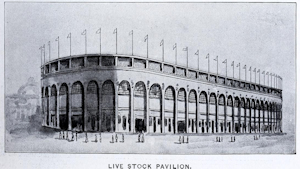 At 3 o’clock 10,000 celebrating visitors filled the stock pavilion to witness an exhibition of athletic sports by the various Sokol societies. This was the crowning event of the day. Something over 300 young men participated in the events. They started with a march that ended in an exhibition of free callisthenic exercises under the direction of Prof. A. Straka.
At 3 o’clock 10,000 celebrating visitors filled the stock pavilion to witness an exhibition of athletic sports by the various Sokol societies. This was the crowning event of the day. Something over 300 young men participated in the events. They started with a march that ended in an exhibition of free callisthenic exercises under the direction of Prof. A. Straka.  Following this drill was another by 200 girls in blue dresses and white trimmed hats. Then there were class exercises on the gymnastic apparatus. Among the contestants were, besides those in Chicago, clubs from Milwaukee, New York, Cleveland, Omaha, (Image Above (E)
Following this drill was another by 200 girls in blue dresses and white trimmed hats. Then there were class exercises on the gymnastic apparatus. Among the contestants were, besides those in Chicago, clubs from Milwaukee, New York, Cleveland, Omaha, (Image Above (E)
Racine, Baltimore, St. Louis, and other points. Prof. Straka was assisted by Joseph Cermak, teacher of calisthenics in the public schools, and Frank Percival. No prizes were given. Image Right (C)
"Recollections of the 1893 Chicago World's Columbian Exposition and Czech Day at the Fair" (A)
After the concert an immeasurable torrent of people poured into the spacious outdoor Exercise Arena for the great Sokol demonstration. The Arena with a capacity of 15,000 persons was full long before the program began, with an overflow standing crowd estimated to reach a total of 20,000 persons.
 The sponsors were welcomed in the Arena by the Fair Committee which could not find words sufficient to express admiration for the Czech Youth. Music rang out and a procession of 368 robust Sokols led by Sokol Peter Straka entered the Arena causing noisy long lasting cheers and applause. They performed an exercise routine which had been done at the Sokol Slet in Praha. It was accompanied with music and received enthusiastic applause. This was followed by a demonstration of training with dumbells and then 34 groups performed on the various types of exercise equipment. At the same time a demonstration of physical exercises ((Image Above (C)) was done by students of the evening school. Josef Cermak a famous Sokol leader arranged these exercises. The moral success of the Sokol appearance was decisive and many of the Fair officials visited and talked with the Czech young people with great enthusiasm.
The sponsors were welcomed in the Arena by the Fair Committee which could not find words sufficient to express admiration for the Czech Youth. Music rang out and a procession of 368 robust Sokols led by Sokol Peter Straka entered the Arena causing noisy long lasting cheers and applause. They performed an exercise routine which had been done at the Sokol Slet in Praha. It was accompanied with music and received enthusiastic applause. This was followed by a demonstration of training with dumbells and then 34 groups performed on the various types of exercise equipment. At the same time a demonstration of physical exercises ((Image Above (C)) was done by students of the evening school. Josef Cermak a famous Sokol leader arranged these exercises. The moral success of the Sokol appearance was decisive and many of the Fair officials visited and talked with the Czech young people with great enthusiasm.
(NOTE) For several days after Bohemian Day Czech Athletic organizations participated in events and competition in Chicago.
Bohemian Athletic Contests
Chicago Tribune, Chicago, Illinois, Monday, August 14, 1893, Page 7.
Under the auspices of the Narodni Jednota (Bohemian National Gymnastic Association, composed of thirty -four athletic societies, 2,500 members in eleven States, with eight in Chicago, the sixth athletic tournament will be hold at the Second Regiment Infantry Armory. Washington Boulevard and Curtis Monday and Tuesday, beginning at 9 a.m. The contests will include exercises on apparatus, leaping (forward and upward), dumbbell climbing, fencing, and Indian clubs. The will be badges and diplomas of honor. The contestants will be 400 Bohemian Turners, the same performed at the World's Fair last Saturday. The judges are: F. Lier. E. Chrudimsky. R. Triska, Milvoj Hasok, V. E. Hirschauer, Antonin Kment, Alois Stok, Pete Churan, Tomas Nadr, Josef Harapat, Otto Chvaiovsky, E. Kounovsky .
Displays of Arts, Crafts, and Products
The Bohemian Voice, Volume 2, No. 1 September 1, 1893
https://digitalcommons.unomaha.edu/bohemian/
The Bohemian women, who are certainly more progressive than their sisters in Austria or Germany,* have applied to the board of lady managers for separate space in the Austrian section of the Women's Building; the request was granted in Chicago, but refused in Vienna under the pretext that the application had come "too late." Having been so courteously treated at Vienna, they declined to place their exhibits under the Austrian flag and decided to send only a few characteristic exhibits to Chicago. In order to secure them an independent position, they have donated their exhibits to Mrs. Bertha H. Palmer in trust for a women's museum to be erected in Chicago. Bohemian peasant women have sent two hundred pieces of embroidery of exquisite designs with motives taken from nature's realms, the school of nature being their only educator. These embroideries are exhibited in the north-east corner of the Gallery of Honor, in cases numbered eleven and fourteen. On the other hand, Bohemian women writers exhibit three hundred and seven volumes of literary works, including novels, books on the art of cooking, education, physical training, history, hygiene, journals, a book of travels, and several musical compositions. This is a very creditable showing.
The men of Bohemia have not been as fortunate as their sisters, for the former are obliged to pose as "Austrians"— a term wholly unknown to ethnology. Most of the Bohemian artists refused their co-operation as there was to be no Bohemian section in the Art Building; hence only five Bohemian artists are represented in the Austrian section by ten oil paintings, the best of which—and doubtlessly also the best and most admired of the entire section— is the famous "Defenestration" by Vaclav Brozik, representing that fatal incident which precipitated the Thirty Years' War in 1618. (You can view an image of the painting here: https://english.radio.cz/vaclav-brozik-painter-czech-history-8711180).
The industrial superiority of Bohemia asserts itself most emphatically in the Manufactures and Liberal Arts exhibit. The Austrian section of the Manufactures Building makes an impression upon the visitor as though Austria were composed of two parts: Bohemia and Vienna, which have supplied nearly all the exhibits. By far the most attractive "is the exhibit of Bohemian glass, notedly that of the  Bohemian nobleman, Count Harrach. Bohemian glass has been justly famous for centuries and in the delicacy of execution and fineness of coloring has never been surpassed. "The showing of glass by this country (Bohemia)," says a Chicago paper, "is comprised of an endless variety, both of shape and embellishment ••• • The cutting is exquisite. The incisions are so deeply made that the effect from the front surface is that of a beautiful modeled subject. There are loving cups, and plaques•••-goblets and tankards enameled with bunches of flowers • - - - There is every conceivable gradation of toning. The Bohemian glass is a color study. The sea greens, violets, bluish greens, ambers, canary yellows, emerald greens, rose, ruby, coppers dark and light, cobalt blues, combined with gilt and enamels^ are endless in variety and shape." The cases also contain skillful imitations of precious stones which it is most difficult to tell from real jewels. (Image Left: Bohemian Glass (F))
Bohemian nobleman, Count Harrach. Bohemian glass has been justly famous for centuries and in the delicacy of execution and fineness of coloring has never been surpassed. "The showing of glass by this country (Bohemia)," says a Chicago paper, "is comprised of an endless variety, both of shape and embellishment ••• • The cutting is exquisite. The incisions are so deeply made that the effect from the front surface is that of a beautiful modeled subject. There are loving cups, and plaques•••-goblets and tankards enameled with bunches of flowers • - - - There is every conceivable gradation of toning. The Bohemian glass is a color study. The sea greens, violets, bluish greens, ambers, canary yellows, emerald greens, rose, ruby, coppers dark and light, cobalt blues, combined with gilt and enamels^ are endless in variety and shape." The cases also contain skillful imitations of precious stones which it is most difficult to tell from real jewels. (Image Left: Bohemian Glass (F))
The Bohemian jewelers of Prague make a fine display of garnet jewelry. The Bohemian garnet, resembling ruby in its color, is a beautiful stone. There we find it employed in ornamenting bracelets, necklaces, rings, combs, crosses, scarf-pins (in the shape of lyres, flowers, butterflies, etc ), picture frames, book covers, etc. The exhibit of Mr. Jira, of Prague, is particularly noteworthy. His designs are original, mostly in styles of the renaissance- A masterly work is his baton of ivory incrusted with garnets forming linden and laurel leaves. Next in importance is the exhibit of Bohemian porcelain and majolica which is both varied and instructive. In the art of coloring chinaware Bohemians have but few rivals. J. J. KRAL
Resources:
A."Recollections of the 1893 Chicago World's Columbian Exposition and Czech Day at the Fair", Translation by Robert O. Uher, KORENY, The Journal of the Czech and Slovak American Genealogy Society of Illinois, Winter 2001, Page 1.
B. "Cesky Den - Bohemian Day" - The Bohemian Voice, Omaha Nebraska, September 1, 1893, Page 3 - Vojta Naprstek, University of Nebraska at Omaha, Digital Commons Holdings.
C. The Amerikan Kalendar, Chicago, Illinois, Publisher August Geringer, 1894, Page 199 - 203.
D. "Pilsen Historic District", Commission on Chicago, Landmarks, The City of Chicago, 2nd Printing, May, 2019.
E. "Gems of Wonderful Chicago and the World's Fair", George Melville, by Wonderful Chicago, Monadnock Builiding, Chicago, Illinois, 1893, Page 81.
F. Shepp's World's Fair Photographed, James W. and Daniel B. Shepps, Globe Publishing Company, Chicago, Illinois, 1893.
Exposition Ticket is not an authentic image, used for visualization purposes only.
